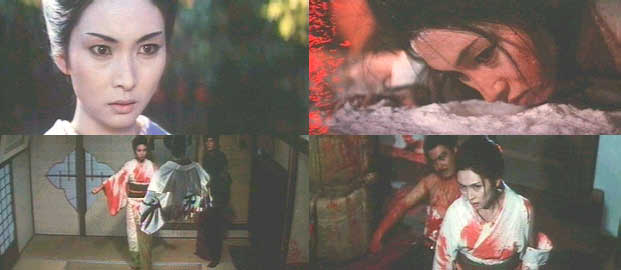Kill Bill: So Far
From So Close
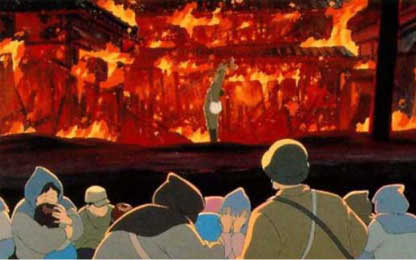
Tokyo: We Are Coming
Only thirty years before the release of “Lady
Snowblood,” several million New Yorkers cheered a vast patriotic parade
that streamed up Fifth Avenue for eleven hours in June 1942. The
evident highlight was a float depicting a big American eagle swooping down
on a herd of yellow rats. As historian John Dower has observed in
War Without Mercy, this caricature captured the essential symbolic features
of racist characterization of the American stance toward Japanese people
– the strong individual versus an undifferentiated pack of vermin denied
any acknowledgement of humanity – an embodiment of the iconic image of
the yellow hordes of Asia.
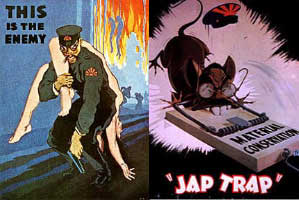
Abundant contemporary imagery of rats, insects,
monkeys or vipers was publicly invoked as justification for exterminationist
rhetoric advocating wholesale slaughter of the Japanese. “Rodent
Exterminator” was stenciled on helmets of many Marines during the 1944
invasion of Iwo Jima. The collection of body parts as trophies from
dead (and living) Japanese was so commonplace that personnel returning
from the Pacific theater were routinely screened for trophy possession
prior to embarkation. In 1943 the magazine Leatherneck published
a photograph of Japanese corpses with an uppercase headline reading “Good
Japs,” while the following year Life published a full-page photograph of
an attractive blonde posing with a Japanese skull. Another photograph
showed Japanese skulls as ornaments on American military vehicles.
Contemporary Japanese reaction was to view such material as indicative
of the American character. For their part, officially sanctioned
American perspectives endorsed notions that the Japanese were mad or crazy
with a perverse wish to die, and deserved the death brought to them by
Americans.
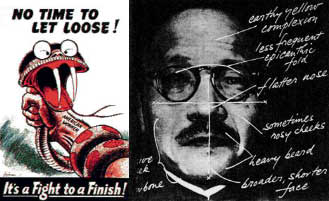
Until the 1960’s, American men’s pulp fiction
magazines blatantly co-mingled World War II propaganda imagery of the Japanese
with depictions of successively demonized Asian adversaries – Koreans,
Chinese, and Vietnamese – to invoke an all-purpose stereotype of an undifferentiated
mass fundamentally unworthy of life. Numerous war movies during and
since Word War II have portrayed the mass killing of people who had been
rendered less than human in this manner.
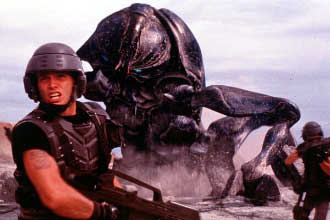
Perhaps most tellingly, the locus of these
devices in the fears and needs of predominantly white America is suggested
by Paul Verhoeven’s futuristic war film “Starship Troopers” (1997).
Verhoeven’s depiction of endless war against lethal “bugs” was deliberately
designed to engage the atavistic hatreds of so many Hollywood Pacific War
movies. By the device of constructing the enemy of the young (mainly
Caucasian) heroes as large, lethal insects, Verhoeven was able to examine
the genocidal corollaries of racial hatred during war, including the attribution
of lack of pain, individuality, conscience or any other human quality to
the demonized, bug-like enemy.
 Postwar Hollywood also peddled the stereotype
of the soft-spoken, demure “Lotus Blossom” as emblematic of Japanese women
as well as the “Dragon Lady” of film noir. White actors continued
the practice of “yellowfacing” (playing Asian roles) until quite recently
– including Sean Connery in “You Only Live Twice” (1967) and David Carradine
in the 1972 television series “Kung Fu” – suggesting that Caucasians could
appropriate the requisite physique and role. Both stage productions
and film noir perpetuated portrayals of Asia and Asians as the object of
limitless fantasy and danger, involving opportunities for “exotic” romance,
miscegenation or fear.
Postwar Hollywood also peddled the stereotype
of the soft-spoken, demure “Lotus Blossom” as emblematic of Japanese women
as well as the “Dragon Lady” of film noir. White actors continued
the practice of “yellowfacing” (playing Asian roles) until quite recently
– including Sean Connery in “You Only Live Twice” (1967) and David Carradine
in the 1972 television series “Kung Fu” – suggesting that Caucasians could
appropriate the requisite physique and role. Both stage productions
and film noir perpetuated portrayals of Asia and Asians as the object of
limitless fantasy and danger, involving opportunities for “exotic” romance,
miscegenation or fear.
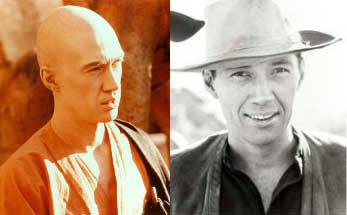 As Jeff Yang, Dina Gan and Terry Hong have commented
in Eastern Standard Time, Western popular cultural products have been frequently
so damaging in their depictions of Asians, even when not explicitly seeking
to be so. Against such a recent background of extremes in cultural
representation, ranging from literal characterization as subhuman vermin
(rats, snakes, insects), through absence (“yellowfacing”) to the false
exoticism of “Orientalism,” contemporary American film depictions of conflict
with Japanese people should tread carefully on controversial ground.
Scott Hicks’ “Snow Falling On Cedars” (1999) has certainly managed this.
“Kill Bill” has not.
As Jeff Yang, Dina Gan and Terry Hong have commented
in Eastern Standard Time, Western popular cultural products have been frequently
so damaging in their depictions of Asians, even when not explicitly seeking
to be so. Against such a recent background of extremes in cultural
representation, ranging from literal characterization as subhuman vermin
(rats, snakes, insects), through absence (“yellowfacing”) to the false
exoticism of “Orientalism,” contemporary American film depictions of conflict
with Japanese people should tread carefully on controversial ground.
Scott Hicks’ “Snow Falling On Cedars” (1999) has certainly managed this.
“Kill Bill” has not.
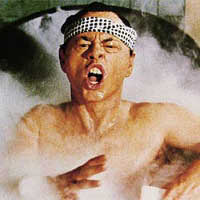 Among the problematic associations suggested by
“Kill Bill,” two in particular stand out when considered in relation to
the above history of racist characterization of the Japanese. The
first involves the conspicuously collective, dehumanized, mass death of
the Japanese “Crazy 88” gang at the hands of a single, brightly clad, blonde
Caucasian. Film and cultural critic Armand White has described the
death of Vivica A. Fox’s character “Vernita Green” in “Kill Bill” as butchering
by a white woman that continues white supremacist patriarchal film conventions.
Much the same could be said about the deaths of so many Japanese characters,
with the additional problematic that they wear masks and are collectively
labeled “crazy” (the “Crazy 88” gang) – devices reminiscent of wartime
notions of the Japanese as an undifferentiated mass of suicidally crazy
lesser beings. The solitary eagle scatters a pack of rats.
A second, related problem concerns the triumphal address by Thurman’s character
“The Bride” at the conclusion of this bloody combat. After surveying
the scene of carnage from above, “The Bride” announces that the wounded
survivors may leave but that their severed limbs remain hers. This
is reminiscent of the historical practice of taking body parts as battlefield
trophies. Historian John Dower has traced the roots of exterminationist
ideology against the Japanese to wars against Native American peoples during
the late Nineteenth Century. Perhaps the final scalping of “O-Ren
Ishii” in “Kill Bill” can be seen as part of this larger trajectory.
Among the problematic associations suggested by
“Kill Bill,” two in particular stand out when considered in relation to
the above history of racist characterization of the Japanese. The
first involves the conspicuously collective, dehumanized, mass death of
the Japanese “Crazy 88” gang at the hands of a single, brightly clad, blonde
Caucasian. Film and cultural critic Armand White has described the
death of Vivica A. Fox’s character “Vernita Green” in “Kill Bill” as butchering
by a white woman that continues white supremacist patriarchal film conventions.
Much the same could be said about the deaths of so many Japanese characters,
with the additional problematic that they wear masks and are collectively
labeled “crazy” (the “Crazy 88” gang) – devices reminiscent of wartime
notions of the Japanese as an undifferentiated mass of suicidally crazy
lesser beings. The solitary eagle scatters a pack of rats.
A second, related problem concerns the triumphal address by Thurman’s character
“The Bride” at the conclusion of this bloody combat. After surveying
the scene of carnage from above, “The Bride” announces that the wounded
survivors may leave but that their severed limbs remain hers. This
is reminiscent of the historical practice of taking body parts as battlefield
trophies. Historian John Dower has traced the roots of exterminationist
ideology against the Japanese to wars against Native American peoples during
the late Nineteenth Century. Perhaps the final scalping of “O-Ren
Ishii” in “Kill Bill” can be seen as part of this larger trajectory.

Other difficulties include the status of supporting
characters. Is Julie Dreyfus as “Sofie Fatale” intended to pass as
an Asian? Does Lucy Liu’s half-American “O-Ren Ishii” suggest references
to the continued American military presence and basing in Japan?
Is it necessary to depict the head of the Tokyo yakuza as half-American?
The prominence of non-Japanese in these key roles connotes a certain powerlessness
and possible cultural subjugation, while Liu’s “O-Ren Ishii” also strays
into the realm of the stereotyped “Dragon Lady” of Orientalist myth with
her sudden profanity and gratuitously immoderate violence. Even the
selection of poisonous snakes as codenames raises potential problems of
association with past usage.
 Despite certain misgivings regarding its content,
many critics have nevertheless acknowledged the impressive visual staging,
spectacle and lush cinematography of “Kill Bill.” In Visual Intelligence,
Ann Marie Seward Barry has proposed recognizing a “New Wave” in action
film, termed the “New Violence.” This seeks to combine special effects
and visual aesthetics in ways that make violence both exciting and beautiful.
The marriage of brutality and aesthetically pleasing forms is especially
seductive, softening and “normalizing” the impact of the violence and may
even imbue it with sensuality. The resulting perceptual dissonance
can be heightened by certain technical features of filmmaking. In
shooting “Pulp Fiction” (1994), for example, Tarantino used extremely slow
film stock showing virtually no grain. This yields an unusually luminous
print allowing for depth of field and particular visual beauty. It
may be critically important to reflect on how the technical rendering of
a scene can deflect critical analysis of its content and narrative implications.
If the fight scene is “beautifully filmed” does this vitiate its barbarism
and possible political import? It should not, and the striking visual
aesthetics of “Kill Bill” also should not distract the viewer from its
reading possibilities.
Despite certain misgivings regarding its content,
many critics have nevertheless acknowledged the impressive visual staging,
spectacle and lush cinematography of “Kill Bill.” In Visual Intelligence,
Ann Marie Seward Barry has proposed recognizing a “New Wave” in action
film, termed the “New Violence.” This seeks to combine special effects
and visual aesthetics in ways that make violence both exciting and beautiful.
The marriage of brutality and aesthetically pleasing forms is especially
seductive, softening and “normalizing” the impact of the violence and may
even imbue it with sensuality. The resulting perceptual dissonance
can be heightened by certain technical features of filmmaking. In
shooting “Pulp Fiction” (1994), for example, Tarantino used extremely slow
film stock showing virtually no grain. This yields an unusually luminous
print allowing for depth of field and particular visual beauty. It
may be critically important to reflect on how the technical rendering of
a scene can deflect critical analysis of its content and narrative implications.
If the fight scene is “beautifully filmed” does this vitiate its barbarism
and possible political import? It should not, and the striking visual
aesthetics of “Kill Bill” also should not distract the viewer from its
reading possibilities.
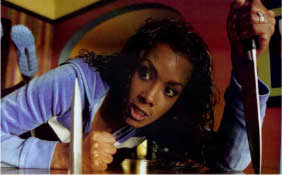 Contemporary theories of spectatorship emphasize
reading strategies rather than constructed meanings. “Kill Bill”
may certainly have been directed and produced as a visually beguiling homage
to “grindhouse” cinema, but that does not limit the permissible reading
strategies. Technically sophisticated, it fails to deliver improvements
to the key narratives of Asian action cinema and ultimately loses their
threads. More troubling, the film also opens the possibility for
readings consistent with historical animosities and stereotypes.
It is not necessary to argue whether these were intentionally woven into
the narrative. Such reading strategies can readily be adopted whenever
the narrative fails to avoid continuity with certain charged historical
themes. Conventions of narrative and cinematic presentation may be
sufficient in their evocation of culturally repressed but not forgotten
themes of hatred and supremacy. It bears repeating that identical
acts performed exclusively by Asian characters (or exclusively on Caucasian
characters) would not raise such questions. They would be located
in a self-contained cultural space, and it seems imprudent to not recognize
this explicitly.
Contemporary theories of spectatorship emphasize
reading strategies rather than constructed meanings. “Kill Bill”
may certainly have been directed and produced as a visually beguiling homage
to “grindhouse” cinema, but that does not limit the permissible reading
strategies. Technically sophisticated, it fails to deliver improvements
to the key narratives of Asian action cinema and ultimately loses their
threads. More troubling, the film also opens the possibility for
readings consistent with historical animosities and stereotypes.
It is not necessary to argue whether these were intentionally woven into
the narrative. Such reading strategies can readily be adopted whenever
the narrative fails to avoid continuity with certain charged historical
themes. Conventions of narrative and cinematic presentation may be
sufficient in their evocation of culturally repressed but not forgotten
themes of hatred and supremacy. It bears repeating that identical
acts performed exclusively by Asian characters (or exclusively on Caucasian
characters) would not raise such questions. They would be located
in a self-contained cultural space, and it seems imprudent to not recognize
this explicitly.
(Click to continue)
All written material copyrights
by T. P. (2003)
